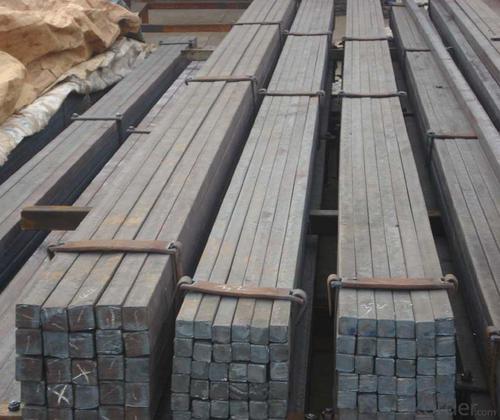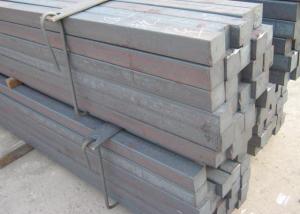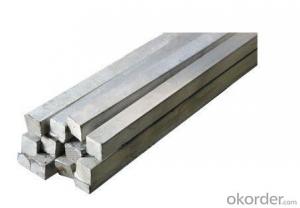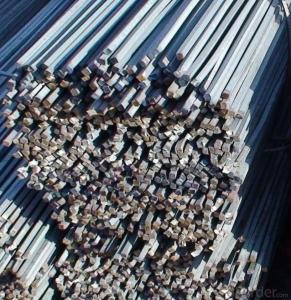High Quality GB Standard Steel Square Bar 38mm-45mm
- Loading Port:
- Tianjin
- Payment Terms:
- TT OR LC
- Min Order Qty:
- 25 m.t
- Supply Capability:
- 10000 m.t/month
OKorder Service Pledge
OKorder Financial Service
You Might Also Like
Product Description:
We offer Square Steel Bar with grade Q195 / Q235
Specifications of Square Steel Bar:
-Standard: GB,
-Grade: Q195/Q235 or equivalent.
Chemical Composition:
-Chemical Composition. Q195
Standard | Grade | Element (%) | ||||
GB | Q195 | C | Mn | S | P | Si |
0.06~0.12 | 0.25~0.50 | ≤0.050 | ≤0.045 | ≤0.30 | ||
-Chemical Composition. Q235
Standard | Grade | Element (%) | ||||
GB | Q235B | C | Mn | S | P | Si |
0.12~0.20 | 0.30~0.70 | ≤0.045 | ≤0.045 | ≤0.30 | ||
Measures and Tolerances of Square Steel Bar:

(The section of Square Steel Bar)
-The length of a side and the theoretical weight of Square Steel.
Length of a side(a, mm) | Theoretical weight(kg/m) | Length of a side(a, mm) | Theoretical weight(kg/m) |
6 | 0.283 | 32 | 8.04 |
7 | 0.385 | *33 | 8.55 |
8 | 0.502 | 34 | 9.07 |
9 | 0.636 | *35 | 9.62 |
10 | 0.785 | 36 | 10.17 |
11 | 0.950 | 38 | 11.24 |
12 | 1.13 | 40 | 12.56 |
13 | 1.33 | 42 | 13.85 |
14 | 1.54 | 45 | 15.90 |
15 | 1.77 | 48 | 18.09 |
16 | 2.01 | 50 | 19.63 |
17 | 2.27 | 53 | 22.05 |
18 | 2.54 | *55 | 23.6 |
19 | 2.82 | 56 | 24.61 |
20 | 3.14 | *58 | 26.4 |
21 | 3.46 | 60 | 28.26 |
22 | 3.80 | 63 | 31.16 |
*23 | 4.15 | *65 | 33.17 |
24 | 4.52 | *68 | 36.3 |
25 | 4.91 | 79 | 38.49 |
26 | 5.30 | 75 | 44.16 |
*27 | 5.72 | 80 | 50.24 |
28 | 6.15 | 85 | 56.72 |
*29 | 6.60 | 90 | 63.59 |
30 | 7.06 | 95 | 70.85 |
*31 | 7.54 | 100 | 78.50 |
Notes:
1, The theoretical weights in the list, base on the density of 7.85 g/cm3.
2, The numbers with *mean that they are not regulars or we don’t offer them.
-The allowed tolerance of Square Steel:
Length of a side(mm) | Allowed Tolerance | ||
Group1 | Group2 | Group3 | |
5.5~7 | ±0.20 | ±0.30 | ±0.40 |
7~20 | ±0.25 | ±0.35 | ±0.40 |
20~30 | ±0.30 | ±0.40 | ±0.50 |
30~50 | ±0.40 | ±0.50 | ±0.60 |
60~80 | ±0.60 | ±0.70 | ±0.80 |
80~110 | ±0.90 | ±1.0 | ±1.1 |
110~150 | ±1.2 | ±1.3 | ±1.1 |
150~190 | ―― | ―― | ±2.0 |
190~250 | ―― | ―― | ±2.5 |
Usage/Applications of Steel Square Bar:
-The Square Steel is normally used as structure steel.
-Row material for other structure steel like steel angles, channels, I-beams, H-beams, etc…
Packaging & Delivery of Steel Square Bar:
-Packing Detail: The products can be packed in bundles by steel wires.
-Marks:
1, Tag marks: the tag marks will be tied up to each bundle of the products. The information is usually including supplier’s logo and name, product name, made in China, products’ specifications, the painted color and other information requested by customers.
2, Color marks: we will paint both ends of the bundles of these products to make sure that they are more evident. It’s will be more convenient for the customers to distinguish them at the destination port.
-Delivery Detail: 30~45 working days after receive buyer’s T.T. or L/C.
Transportation:
-The products can be delivered by bulk vessel or by container. As for container, products with the length of 6m will be loaded in 20’ container, with 9m or 12m, in 40’ container.
-The maximum quantity of loading of container is 25 tons.
-The products usually are transported to the nearest port from the production place.
- Q: How do you use a steel square to measure the height of a step?
- In order to measure the height of a step using a steel square, the following steps can be followed: 1. Position the steel square perpendicularly on the edge of the step, with the longer side parallel to the ground. 2. Slide the square along the vertical face of the step until the shorter side touches the top edge. 3. Once the square is correctly positioned, take note of the measurement on the longer side where it intersects with the top edge. This measurement will indicate the step's height. 4. Ensure the square is securely held to prevent any movement during the measurement process. It is also important to accurately read the measurement. 5. Repeat this process for each step to consistently measure the height.
- Q: What are some common conversions and calculations that can be done with a steel square?
- A steel square, also known as a framing square or carpenter's square, is a versatile tool used in carpentry and woodworking. It consists of a long blade and a shorter tongue that meet at a right angle. Here are some common conversions and calculations that can be done with a steel square: 1. Measuring and marking: The steel square can be used to measure and mark straight lines or right angles on a piece of wood or other materials. It is particularly useful in determining 90-degree angles for accurate cuts and joint construction. 2. Determining squareness: By using the square's 90-degree angle, you can check the squareness of corners and ensure they are perfectly perpendicular. This is important for constructing frames, cabinets, and other structures. 3. Finding roof pitch: Carpenters often use a steel square to determine the pitch or slope of a roof. By placing the square on the roof surface and aligning it with the rafters, the angle of the roof pitch can be measured. 4. Calculating rafter lengths: A steel square can also be used to calculate the length of rafters for roofs. By using the square's markings and angles, carpenters can quickly determine the appropriate length of rafters needed for a specific roof design. 5. Making angle cuts: The steel square can be used to mark and guide angle cuts on wood or other materials. By aligning the square's blade or tongue with the desired angle and marking the cut line, precise angle cuts can be achieved. 6. Creating parallel lines: The square's straight edge can be used to draw parallel lines by simply sliding it along the edge of the material while keeping it aligned with the desired distance. 7. Measuring and transferring dimensions: The square can be used as a ruler or measuring device for both straight and diagonal measurements. It is useful in transferring measurements from one piece of material to another accurately. 8. Checking flatness: The steel square can also be used to check the flatness of a surface. By placing it on a flat surface and observing if the entire length is in contact, any deviations or unevenness can be detected. Overall, a steel square is a versatile tool that can be used for a wide range of conversions and calculations in carpentry and woodworking. Its ability to measure, mark, determine angles, and assist in various construction tasks makes it an essential tool for any carpenter or woodworker.
- Q: Can a steel square be used for checking the alignment of wall cabinets?
- Checking the alignment of wall cabinets is possible with the use of a steel square. This versatile tool, also known as a framing square or a carpenter's square, is commonly utilized by carpenters and construction professionals to measure and confirm right angles. To check the alignment of wall cabinets, simply position the steel square against the corner of the cabinet and verify that it is square and properly aligned. The straight edges of the steel square are ideal for checking the parallelism and straightness of the cabinet sides. Moreover, the inside edge of the steel square can be employed to confirm that the corners are at 90-degree angles. All in all, the use of a steel square is highly beneficial for ensuring the appropriate alignment of wall cabinets during installation.
- Q: Can a steel square be used for precision measuring?
- Yes, a steel square can be used for precision measuring. A steel square, also known as a combination square, is a versatile measuring tool that is commonly used in woodworking and metalworking. It consists of a steel blade and a steel head, which can be adjusted and locked at various angles to accurately measure and mark materials. Steel squares are designed to be accurate and reliable, with clear markings and precise measurements. They can be used for a variety of measurements, such as determining right angles, measuring and marking 45-degree angles, checking the flatness of surfaces, and transferring measurements. The steel construction ensures durability and stability, making it suitable for precise measurements over extended periods of time. However, it is important to note that while steel squares can provide precise measurements, they have their limitations. They may not be suitable for measuring extremely small dimensions or for highly sensitive measurements that require specialized tools. In such cases, more precise measuring instruments, such as micrometers or calipers, may be required. Nonetheless, for most general precision measuring tasks, a steel square can be a reliable and accurate tool.
- Q: How do you use a steel square to determine angles for door casing?
- To use a steel square to determine angles for door casing, you can follow these steps: 1. Measure and mark the width and height of the door casing on the wall. 2. Place the steel square against the edge of the casing, aligning one leg of the square with the width mark and the other leg with the height mark. 3. Ensure the square is level and firmly held against the casing. 4. With a pencil, trace along the edge of the steel square to create a straight line on the casing. 5. Repeat the process on the opposite side of the casing to ensure accuracy. 6. Measure the angle formed by the two lines on the casing using a protractor or the angle guide on the steel square. 7. Use this angle measurement to cut the casing accurately, ensuring it fits perfectly around the door frame. By using a steel square, you can easily determine and transfer the correct angles onto the door casing for precise installation.
- Q: How do you use a steel square to measure and mark angles?
- To measure and mark angles using a steel square, follow these steps: 1. Get acquainted with the components of a steel square. It typically comprises two arms that meet at a right angle, creating an L-shaped structure. Each arm has a face and an edge. 2. Determine the angle you wish to measure. Let's assume you want to measure a 45-degree angle. 3. Position the longer arm of the steel square against the edge of the material or surface to be marked. Ensure that the shorter arm is facing the direction in which you want to measure the angle. 4. Align the edge of the shorter arm with the starting point of the angle you want to measure. Make sure the edge is flush with the material or surface. 5. Observe the scale or graduations on the face of the longer arm. Locate the marking that corresponds to the desired angle, which in this case is 45 degrees. 6. Once you identify the correct marking, use a pencil or scribe to make a small mark on the material or surface along the edge of the shorter arm. 7. Now, rotate the steel square while keeping the longer arm firmly against the edge of the material or surface. 8. Continue rotating until the edge of the shorter arm aligns with the desired endpoint of the angle you want to measure. 9. Reexamine the scale or graduations on the face of the longer arm and find the marking that aligns with the endpoint of your angle. 10. Mark the material or surface at this point using a pencil or scribe. 11. Finally, draw a straight line connecting the two marked points to create the desired angle. Remember, when using a steel square for angle measurement and marking, precision is paramount. Take your time and ensure that the square remains securely in position throughout the process.
- Q: What are some common uses for a steel square in cabinetry?
- A steel square, also known as a framing square or carpenter's square, is a versatile tool commonly used in cabinetry for a variety of purposes. Some of the common uses for a steel square in cabinetry include: 1. Layout and marking: A steel square is essential for layout and marking tasks in cabinetry. It helps in accurately marking straight lines, right angles, and precise measurements for various cuts and joints. 2. Checking squareness: Cabinetry requires precise squareness to ensure proper alignment and fit. A steel square can be used to check the squareness of panels, corners, and joints, ensuring that all components are correctly aligned. 3. Marking and cutting angles: Many cabinetry projects require angled cuts for items like mitered corners or beveled edges. A steel square can serve as a guide for marking and cutting precise angles, ensuring that the desired angle is achieved accurately. 4. Measuring and transferring measurements: With its straight edges and measurement scales, a steel square is useful for measuring and transferring measurements in cabinetry. It allows for precise measurements of lengths, widths, and depths, ensuring accuracy in the construction process. 5. Checking and marking for level and plumb: Cabinetry needs to be level and plumb to ensure stability and proper functionality. A steel square can be used to check and mark for level and plumb lines, ensuring that the cabinets are installed correctly. 6. Creating and checking right angles: Right angles are fundamental in cabinetry construction. A steel square can be used to create right angles by aligning its edges with the workpiece, ensuring that corners and joints are square and properly aligned. Overall, a steel square is an indispensable tool in cabinetry, allowing for accurate layout, measurement, and alignment. Its versatility and precision make it an essential tool for any cabinetmaker or carpenter.
- Q: Can a steel square be used for marking out dovetails?
- Yes, a steel square can be used for marking out dovetails. Its straight edges and right angles can help in accurately marking the angles and lines needed for creating dovetail joints. However, it is important to ensure that the steel square is properly aligned and adjusted to ensure precise measurements.
- Q: Can a steel square be used for measuring angles other than right angles?
- Measuring angles other than right angles is not possible with a steel square. This tool, alternatively called a try square or a carpenter's square, is specifically designed to ensure accurate measurements of right angles. Its construction consists of a metal blade with a handle forming an L-shape at a right angle. The main purpose of a steel square is to verify the squareness of corners, mark right angles, and guarantee precise 90-degree angles in carpentry and other construction work. While it might be feasible to estimate or approximate other angles using a steel square, it cannot be relied upon as a precise or dependable tool for measuring angles that deviate from right angles. To measure angles of varying degrees, it is advisable to employ specialized tools like protractors or angle finders.
- Q: How do you measure angles with a steel square?
- To determine the angles of an object or material using a steel square, you may follow these instructions: 1. Position the steel square alongside the material or object whose angle you wish to measure. 2. Align one of the steel square's edges with one side of the desired angle. 3. Examine the scale or markings on the steel square. Typically, one side of the steel square includes a protractor scale. 4. Locate the zero or 90-degree mark on the scale and ensure it aligns with the reference edge of the steel square. 5. Observe the angle created by the other side of the desired angle and the edge of the steel square. 6. Determine the measurement on the scale where the other side of the angle intersects. 7. Record or remember the obtained measurement, which represents the angle of the material or object. Always secure the steel square firmly against the object or material to prevent any inaccuracies. Moreover, if the angle exceeds the steel square's direct measurement capacity, you can employ trigonometry or alternative methods to calculate the angle based on the acquired measurements.
Send your message to us
High Quality GB Standard Steel Square Bar 38mm-45mm
- Loading Port:
- Tianjin
- Payment Terms:
- TT OR LC
- Min Order Qty:
- 25 m.t
- Supply Capability:
- 10000 m.t/month
OKorder Service Pledge
OKorder Financial Service
Similar products
Hot products
Hot Searches




























